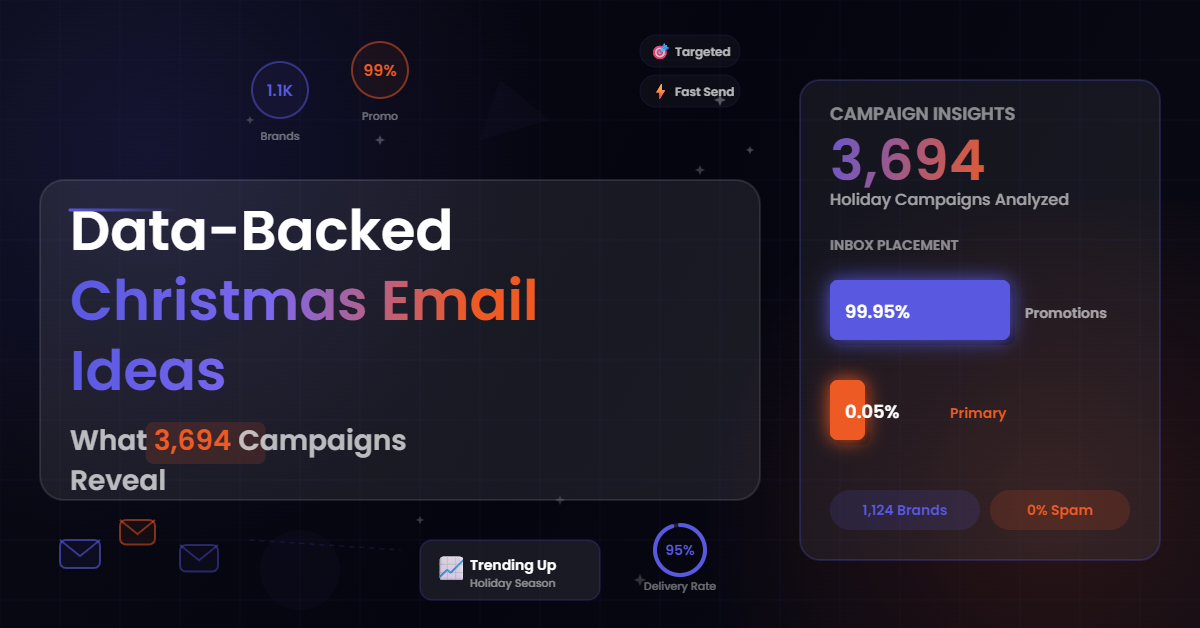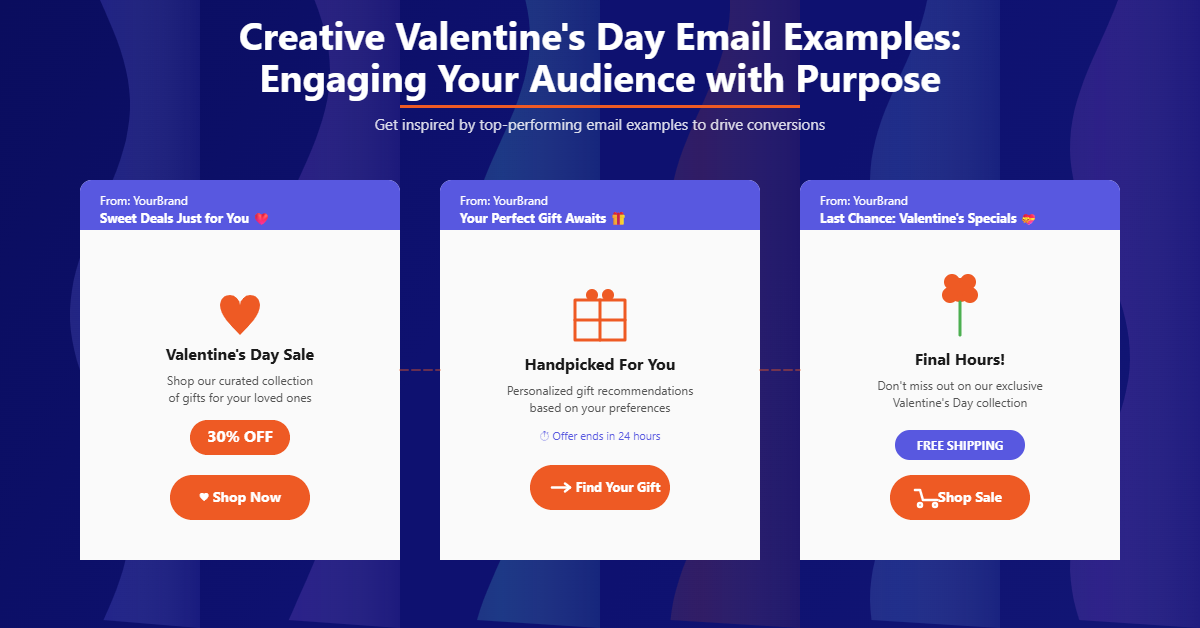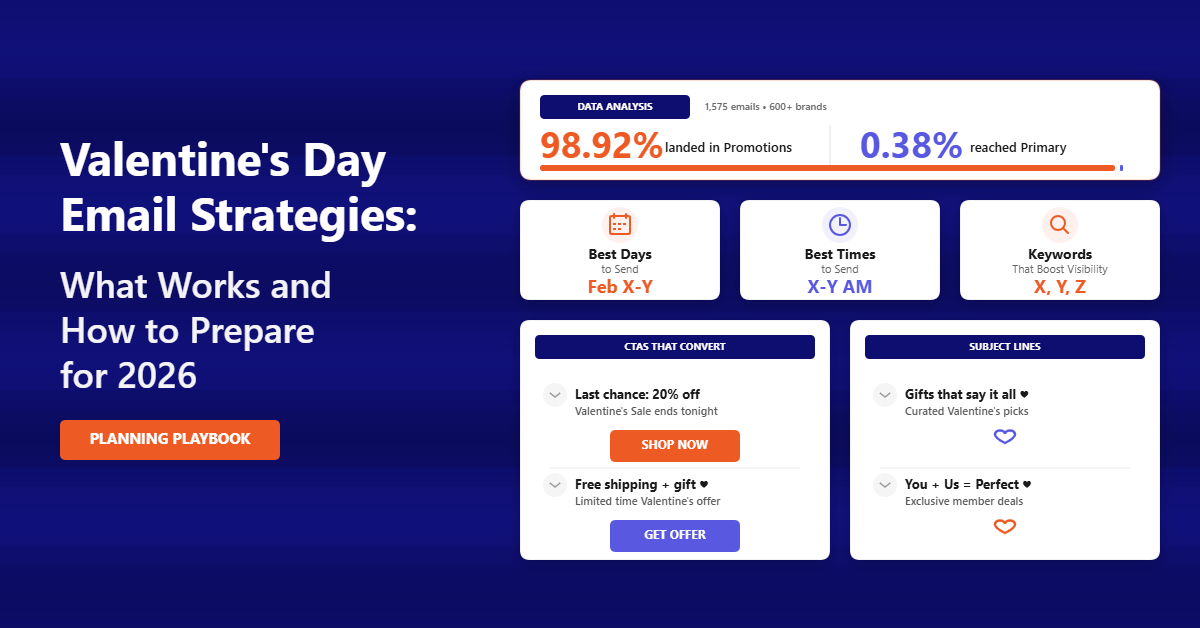Quick Summary
🎄 Since 99.95% of emails land in Promotions, design every Christmas send specifically for Promotions-tab behavior and scanning.
📨 Because 50.18% of brands relied on generic messages, shift your emails toward underused formats like gift guides and cutoff reminders.
⏳ Given urgency CTAs appear in 74.6% of cases, reserve them strategically to stand out instead of blending in.
🧵 With 95.53% using complementary preview text, optimize yours to deliver the specific benefit your subject line only hints at.
🎁 Since post-Christmas sends were just 1.92%, capitalize on this overlooked window to target gift-card and exchange shoppers.
In a recent analysis of 3,694 Christmas emails sent by 1,124 brands, 99.95% landed in the Promotions tab and just 0.05% reached the primary inbox.
Yet there was also a bright spot: 0% hit spam.
The takeaway is simple. The Promotions tab is the arena where you win or lose.
If you want Christmas email ideas that actually move revenue, you build for that environment.
The state of Christmas email marketing
Across 1,124 brands, 3,694 Christmas emails were analyzed. Folder placement tells a clear story.
Only 0.05% made it to the primary inbox, 99.95% went to Promotions, and 0% were flagged as spam. When examined by campaign type, placement was even more uniform: 100% of messages analyzed sat in Promotions.
This environment isn’t a penalty. It is parity. Your competitors face the same placement and the same constraints.
The edge goes to brands that make the Promotions tab work for them with targeted messaging, timing built around shipping guarantees, and subject lines that match consumer intent at each moment of the season.
Where brands invested. And where they didn’t
Campaign types broke down into six buckets. General sale emails were the most common at 983 sends (26.61%).
Shipping reminders accounted for 400 sends (10.83%). Gift guides totaled 228 sends (6.17%).
Last-chance pushes were 159 sends (4.30%). Post-Christmas or Boxing Day style emails came in at 71 sends (1.92%).
The largest bucket, however, was neutral or generic holiday emails at 1,853 sends (50.18%), flagged as a missed opportunity.
If you’re sitting down to plan Christmas email ideas, this distribution gives you your gap analysis. Half the market used generic holiday messaging, while more intentional formats like gift guides, shipping cutoffs, and last-chance alerts were comparatively underused.
Reframing neutral emails into purposeful, high-intent formats is one of the fastest ways to improve results without sending more email.
More Christmas Email Marketing Resources for You
Christmas email ideas that map to intent
Gift guides (6.17%): Turn browsing into buying
Gift guides were relatively rare, yet they match December shopping behavior perfectly.
Subject lines for high performers leaned into words like gift, holiday, Christmas, ideas, guide, perfect, everyone, find, and curated.
Build your guide around real shopper journeys: gifts under $50, gifts for him or her, last-minute digital gifts, and curated bundles by interest or category.
To stand out in Promotions, every element should do a job.
Use a subject line like “Curated Christmas gift ideas for everyone on your list” and a preview text that adds specificity such as “Top-rated picks with guaranteed delivery dates.”
Incorporate social proof from your product reviews and prioritize scannable layouts with 3–5 featured products, not 20.
This is a high-impact way to repurpose neutral holiday sends into conversion-focused emails.
Shipping reminders (10.83%): Everyone opens for deadlines
Shipping reminders convert because they reduce risk for the shopper.
Winning subject line patterns include shipping, order, arrival, guarantee, time, hurry, last, delivery, and today. Tie your message to real cutoffs and state the benefit in plain language.
Call the deadline early in the subject, reinforce it in the preview text, and repeat it in the hero. Pair urgency with clarity: “Order by 2 PM today for Christmas delivery” followed by a CTA that confirms the promise.
Segment your list by shipping zones or loyalty tiers where possible, then send localized cutoffs to remove friction and increase confidence.
Last-chance (4.30%): Scarcity, without the gimmicks
Last-chance campaigns use words like last, chance, final, ends, today, save, sale, and hurry.
These emails are most effective when they follow a sequence: a gift guide, a shipping reminder, then a last-chance alert. The appeal is cumulative. The subject line signals the finality.
The preview text clarifies the stakes: “Final hours for delivery by Christmas—free express upgrade ends at midnight.”
Use a single CTA above the fold and remove secondary links. Reducing choice friction puts the urgency to work and respects mobile users’ attention span in the Promotions tab.
Post-Christmas and Boxing Day (1.92%): The overlooked revenue window
Only 71 sends in this dataset focused on post-Christmas or Boxing Day style offers, despite subject patterns like year, after, deals, sale, winter, and holidays performing well historically.
These campaigns sell to people using gift cards, exchanging sizes, or shopping in winter clearance. They also re-engage subscribers who went quiet during the rush.
Position the email around “New Year, still-gifting” with a subject such as “After-Christmas winter deals you actually want.”
Add loyalty hooks, like bonus points or double rewards for redemptions, to pull gift recipients into your ecosystem.
General sale (26.61%): Don’t blend into the background
General sale emails were the largest intentional category and often featured words like sale, holiday, Christmas, save, deals, gifts, offers, clearance, winter, and shop.
Because so many brands send similar messages, use your preview text and email body to claim a sharper angle.
Anchor on a clear value proposition, such as “Buy more, save more tiers,” highlight limited inventory for top sellers, and inject customer proof from recent reviews.
Tie your creative to a single hero product or bundle rather than a grid of disjointed SKUs.
In a Promotions tab stuffed with sweeping “holiday sale” banners, specificity increases stopping power.
Neutral or generic holiday emails (50.18%): Reframe for intent
More than half of all sends were neutral or generic with subject line themes like Christmas, holiday, holidays, winter, happy, merry, season, and gift.
These welcomes and well-wishes have a role, but they seldom drive purchase on their own. Convert them into revenue-driving touches by attaching intent.
A simple “Happy holidays” becomes “Happy holidays—here’s a curated gift guide for last-minute shoppers,” or “Merry and bright: free expedited shipping through 2 PM today.”
If you want Christmas email ideas that perform, swap generic cheer for purposeful offers, deadlines, or curation.
Your brand voice can remain warm and on-message while your structure moves shoppers forward.
Subject lines that earn attention
Across campaign types, certain keyword clusters in Christmas email subject lines correspond with higher engagement.
Gift guides favored gift, ideas, and curated. Shipping reminders leaned on shipping, order, and guarantee.
Last-chance campaigns used “last”, “final”, and “ends”. Post-Christmas emails tapped “after”, “deals”, and “winter”. General sale leaned on sale, save, and clearance. Neutral sends stuck with holiday greetings.
Use these patterns as building blocks, not templates. The best subject lines pair the right keyword with a concrete benefit.
A guide becomes “Find the perfect gift: curated picks under $50.” A shipping alert becomes “Delivery by Christmas, guaranteed—order today.”
A last-chance push becomes “Final hours: holiday sale ends at midnight.”
The semantics should align with the moment in your funnel. That’s how you stand out in a Promotions-dominated landscape.
CTAs that convert: urgency works, when used intentionally
The dataset shows brands leaned hard into urgency. Of all CTA phrase categories, urgency CTAs accounted for 907 instances (reported as 74.6%).
Soft CTAs showed up 113 times (9.24%). Other CTAs occurred 265 times (21.68%). The dominance of urgency tells you two things. It’s effective for late-season shopping, and it’s easy to overdo.
Match your CTA to the job of the email. Use urgency for last-chance and shipping reminders where time is the main objection.
Use value-led CTAs in gift guides and general sales to emphasize curation or savings. In post-Christmas emails, experiment with redemption language such as “Use your gift card” or “Redeem double points today.”
Keep button copy short, verb-led, and mobile-friendly. One clear CTA above the fold usually outperforms crowded layouts.
More Christmas Email Marketing Resources for You
Preview text: the hidden 100-character advantage
Preview text often functions like a second subject line. In this dataset, 3,529 emails (95.53%) used complementary preview text, 147 (3.98%) repeated the subject, and 18 (0.49%) had no preview at all.
The strong skew toward complementary copy is a best practice worth keeping. Never repeat your subject in the preview. Instead, add context or a specific promise.
Use preview text to clarify the key benefit or deadline the subject teases. If your subject reads “Last day for Christmas delivery,” use preview text to state the cutoff time and shipping method.
If your subject says “Curated gift ideas,” use preview text to specify budget tiers, top-rated picks, or who the gifts are for.
This is particularly powerful in the Promotions tab, where the preview line competes for the same glance as your subject.
Designing for Promotions: build to win where you’ll be seen
With 99.95% of Christmas emails landing in Promotions and 100% of the campaigns in this analysis sitting there by type, optimization for that environment isn’t optional.
Visual hierarchy should be immediate. Lead with a promise in a concise hero and one primary CTA. Use subheads to segment content for scanners. Favor compressed images and alt text for speed and accessibility.
Avoid heavy navigation bars or clutter that makes your message look like a catalog page.
Deliverability remains healthy, 0% spam in this study, so attention, not placement, is the constraint. Respect that constraint by keeping copy tight, images purposeful, and offers obvious without shouting.
Cadence and sequencing: use momentum, not volume
The most effective Christmas email ideas often work as a series, not one-offs. Start with a gift guide to frame choices.
Follow with a shipping reminder to reduce risk. Close with a last-chance alert to harness urgency.
Then circle back with a post-Christmas or winter deals message that converts gift card holders and late shoppers.
Maintain consistent design and message architecture across the series so each send feels like the next logical step.
Keep audience experience front and center. Reducing frequency for non-clickers, throttling reminders once a purchase is made, and using SMS for same-day shipping deadlines protects your list and your revenue. That’s how you turn seasonal noise into a coherent shopper journey.
Measurement that matters
Track the obvious, but optimize for the meaningful. Opens matter less in a high-Promotions environment than clicks, product views, and conversion rate.
Monitor revenue per email and AOV by campaign type. Compare gift guides versus general sales, last-chance versus shipping reminders, and pre- versus post-Christmas sequences.
Use learnings to reweight your campaign mix next season, especially if you’re still sending a high percentage of neutral holiday emails.
Putting it all together with a unified stack
Executing these strategies at speed is easier with a connected toolkit. With TargetBay Email & SMS, you can build segmented gift guides, schedule shipping reminders around real cutoffs, and use the AI email agent to generate on-brand subject line variants that match the proven keyword patterns above.
Layer in TargetBay Reviews to showcase recent photo and video reviews inside your holiday guides for trust at a glance. Close the loop with TargetBay Rewards by offering bonus points or limited-time redemptions in post-Christmas emails to turn new shoppers into loyalists.
A unified flow across email, SMS, reviews, and loyalty gives your Christmas email ideas a compounding effect.
The result is fewer generic messages, more purposeful sends, and a clearer, data-backed path to revenue in a Promotions-first reality.
The bottom line
The data is unequivocal. The Promotions tab is where almost every Christmas email lives, yet the campaigns that match shopper intent still perform.
Shift neutral holiday sends into gift guides, shipping reminders, last-chance alerts, and post-Christmas offers. Use subject line cues aligned to each format, write preview text that adds meaning, and pair urgency with clarity in your CTAs.
If you build for where you’re actually seen and sequence your emails to remove friction at each step, your brand will rise above the seasonal noise.
For eCommerce teams ready to execute fast, unified tools like TargetBay bring these best practices within reach, so your next season’s plan isn’t just festive, it’s measurably effective.






